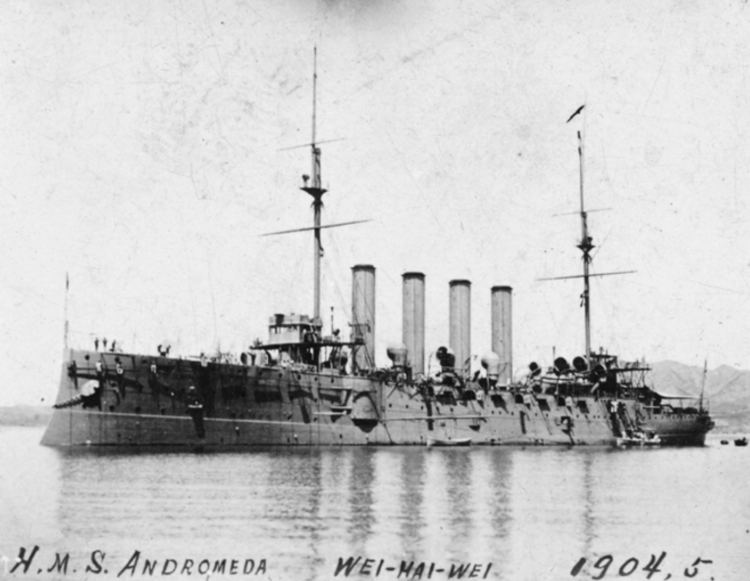Laid down 2 December 1895 Construction started 2 December 1895 Draft 7.77 m | Namesake Andromeda Completed 5 September 1899 Launched 30 April 1897 | |
 | ||
Renamed Powerful II, 23 September 1913Impregnable II November 1919Defiance 20 January 1931 Reclassified As a training ship, 23 September 1913 | ||
HMS Andromeda was one of eight Diadem-class protected cruisers built for the Royal Navy in the 1890s. Upon completion in 1899, the ship was assigned to the Mediterranean Fleet where she helped to escort a royal yacht during its cruise through the Mediterranean Sea. After a refit, she was assigned to the China Station in 1904 and returned home three years later to be reduced to reserve. Andromeda was converted into a training ship in 1913 and remained in that role under various names until 1956. That year she was sold for scrap and broken up in Belgium, the last Pembroke-built ship still afloat.
Contents
Design and description
The Diadem class was designed to protect British merchant shipping from fast cruisers like the Russian Rurik and were smaller versions of the Powerful class. The ships had a length between perpendiculars of 435 feet (132.6 m), a beam of 69 feet (21.0 m) and a draught of 25 feet 6 inches (7.8 m). They displaced 11,000 long tons (11,000 t). The first batch of Diadems were powered by a pair of four-cylinder triple-expansion steam engines, each driving one shaft, which were designed to produce a total of 16,500 indicated horsepower (12,300 kW) and a maximum speed of 20.5 knots (38.0 km/h; 23.6 mph) using steam provided by 30 Belleville boilers. They carried a maximum of 1,900 long tons (1,930 t) of coal and their hulls were sheathed with copper to reduce biofouling. Their complement numbered 677 officers and ratings.
The main armament of the Diadem-class ships consisted of 16 quick-firing (QF) QF 6-inch (152 mm) guns. Four of these were on the forecastle and in the stern, all protected by gun shields. The remaining dozen guns were in armoured casemates on each broadside. The ships carried 200 rounds per gun. Protection against torpedo boats was provided by a dozen QF 12-pounder 3 in (76 mm), 12-cwt guns, for which 300 rounds per gun was provided, and 3 QF 3-pounder (1.9 in (47 mm)) Hotchkiss guns. In addition, the ships carried a pair of Ordnance QF 12-pounder 8-cwt landing guns for use ashore. The ships were also armed with a pair of submerged 18-inch (450 mm) torpedo tubes.
The sloped armoured deck ranged in thickness from 2.5 to 4 inches (64 to 102 mm) on the flat and slopes, respectively. The casemates were protected by 6 inches of Harvey armour while the gun shields had 2 to 4.5 inches (51 to 114 mm) of armour. The conning towers were protected by 12-inch (305 mm) walls and their roofs were 2 inches thick. The tubes protecting the ammunition hoists were also 2 inches thick.
Construction and career
Andromeda was the fifth ship of her name to serve in the Royal Navy and was laid down on 2 December 1895 by Pembroke Dockyard. The ship was launched on 30 April 1897 by Lady Scourfield, wife of Sir Owen Scourfield Bt. She was fitted out at Pembroke Dock until 5 September 1898 and sailed later that month to Portsmouth Dockyard for completion.
Upon completion on 5 September 1899, she was assigned to the Mediterranean Fleet under the command of Captain John Burr, who was relieved on 12 March 1901 by Captain Francis Foley. That month the ship was one of two cruisers tasked to escort the ocean liner HMS Ophir, commissioned as a royal yacht for the world tour of the Duke and Duchess of Cornwall and York (later King George and Queen Mary), from Gibraltar to Malta, and then to Port Said. Captain Christopher Cradock was appointed in command on 24 March 1902, and from 11 June that year Andromeda served as flagship to Rear-Admiral Sir Baldwin Wake Walker, commander of the Cruiser Division of the Mediterranean Fleet. In May 1902 she visited Palermo to attend festivities in connection with the opening of an Agricultural Exhibition by King Victor Emmanuel, and the following month the ship was in Gibraltar for a coronation fête.
Andromeda returned home later that year and began a lengthy refit. She was assigned to the China Station in 1904 and returned home three years later. The ship was reduced to reserve at Chatham Dockyard upon her return, but transferred to Devonport Dockyard shortly afterwards. Andromeda was assigned to the 9th Cruiser Squadron of the new reserve Third Fleet in 1912. The following year the ship was converted to a boys' training ship and renamed Powerful II on 23 September 1913. She was later renamed Impregnable II in November 1919 and finally, HMS Defiance on 20 January 1931, when she became part of the torpedo school. The ship was sold for scrap in 1956 and arrived at Burgt, Belgium, on 14 August to begin demolition.
